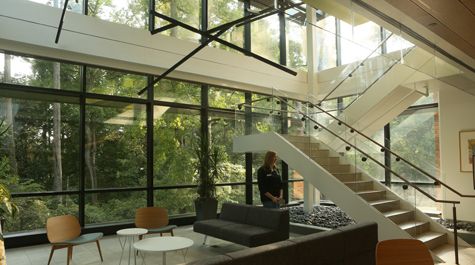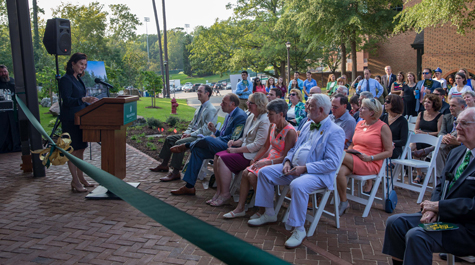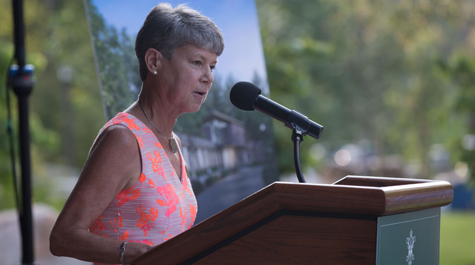Wellness center provides education, support from multiple angles
The McLeod Tyler Wellness Center looks like a different building from each of its four exterior corners — a design that was intentional.
“The multiple planes and the multiple perspectives are designed to connote the multidimensionality of wellness and to be able to see how wellness can change based on where we are and where we move and how dynamic we are,” said Kelly Crace, associate vice president for health and wellness.
The new center, which was dedicated Tuesday, brings together William & Mary’s Office of Health Promotion, Counseling Center, Health Center, and Campus Recreation’s wellness programing under one roof along with the new Center for Mindfulness and Authentic Excellence. With all of those services centrally located, Crace hopes that it will foster closer collaboration between the offices and offer students a chance to learn about the multiple dimensions of wellness in one location.
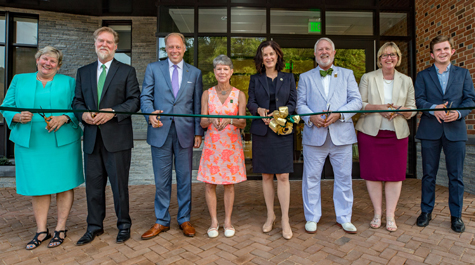 “I want students to see this as a learning center, not a clinic,” he said. “It’s a place where they can learn what wellness looks like for them, whether they’re sick or well or wanting to understand the harmony of wellness, they should be able to find and learn about that here.”
“I want students to see this as a learning center, not a clinic,” he said. “It’s a place where they can learn what wellness looks like for them, whether they’re sick or well or wanting to understand the harmony of wellness, they should be able to find and learn about that here.”
Made possible through the support of namesake donors H. Elizabeth “Bee” McLeod’83, M.B.A. ’91 and honorary alumnus J. Goodenow “Goody” Tyler III, ground was broken for the center in June 2017, and it began offering services to students last week.
An invitational building
The building is located behind the Sadler Center, and its back windows look out into the university’s wildlife flower refuge. The building’s four outdoor features include a meditation labyrinth, life-size Zen garden and social wellness patio equipped with Adirondack chairs. Inspired by the university’s role in the Charter for Compassionate Schools, a compassion garden with large rocks where students may sit and interact was installed in the front of the building.
“It’s a place for students to reflect and meditate on compassion for others and self-compassion,” said Crace. “And that’s at the front of the building because we believe that compassion is the front and center of what we do.”
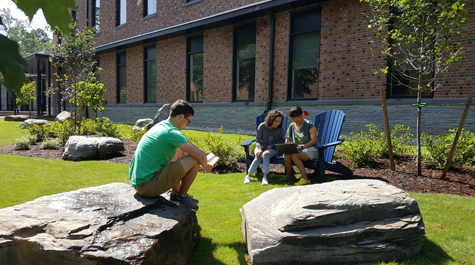 In the lobby, a seating area is located across from a water wall and in front of large windows that were meant to bring nature into the facility, according to Crace.
In the lobby, a seating area is located across from a water wall and in front of large windows that were meant to bring nature into the facility, according to Crace.
“This building is a building that is invitational,” he said. “It invites students to come in. Students are just learning that this is where I’m going to learn about my wellness, and that may be through the Health Center, the Counseling Center — whatever it is. But coming into that building is a positive step, a positive statement about you taking care of yourself, and that really gets at and pushes against the stigma that can often be associated with seeking help.”
New and contemporized
Within the Health Center, located on the first floor, students will find a contemporized facility with state-of-the-art equipment and larger examination and treatment rooms. The center also now includes an isolation room for patients with infectious conditions.
“More than anything, it’s just so nice to have the Health Center centrally located here with the other departments,” said Crace. “It really brings students’ awareness together about what does wellness look like for them. It’s not just the Health Center; it’s not just the Counseling Center. It’s all of it combined together. It provides this natural opportunity and organic opportunity for collaboration.”
Also located on the first floor are two multipurpose rooms with large windows facing the back of the building and a variety of lighting settings that can be changed by those using the rooms for yoga or other purposes. A makerspace provides student health organizations a place to collaborate on peer education efforts.
 Several meditation alcoves are also sprinkled throughout the building. Designed to be comfortable for students anywhere on the neurodiversity spectrum, the spaces may be used without reservations during the building’s regular business hours, Monday-Friday, 8 a.m. to 8 p.m.
Several meditation alcoves are also sprinkled throughout the building. Designed to be comfortable for students anywhere on the neurodiversity spectrum, the spaces may be used without reservations during the building’s regular business hours, Monday-Friday, 8 a.m. to 8 p.m.
Staff offices for Health Promotion and Campus Recreation’s wellness programming are located along one hallway on the first floor. Health Promotion, which had previously been embedded with other departments or located in the periphery of the Campus Center, is planning to host “wellness bursts” and “pop-up wellness initiatives” — featuring such offerings as yoga, massages or blood pressure checks — in or around the building.
Health Promotion is also leading the new Wellness Ambassador program, which includes 75 students who will help to cover the front desk and assist all of the departments in the building in a variety of ways, from helping to create programming to manning events. In addition, Crace said, the students are committing to be cultural ambassadors on campus around issues of wellness.
“They’re not going to enable the stress glorification culture,” he said. “They’re not going to join that culture; they’re going to nudge against that in a way that’s important for our population.”
Classes and programs
The wellness programs offered by Campus Recreation at the center will include yoga, tai chi, expressive movement, massage, acupuncture and biofeedback — all of which will also be offered at the Student Recreation Center. The two will share a scheduling software system, MindBody, for student sign-ups.
Group fitness and wellness classes — excluding clinical services like massage and acupuncture — are all free for students this year.
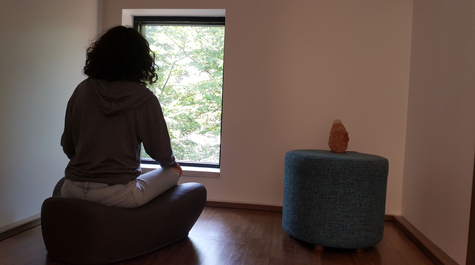 “It’s something we’ve wanted to do for some time to be more inclusive, to not create another barrier to access these services,” said Crace. “And even though the Fitwell pass is pretty cheap and affordable, there are some people who can’t do that, so we’re going to try it as a pilot this year to see how it goes. But we just wanted to commit to offering the services for free.”
“It’s something we’ve wanted to do for some time to be more inclusive, to not create another barrier to access these services,” said Crace. “And even though the Fitwell pass is pretty cheap and affordable, there are some people who can’t do that, so we’re going to try it as a pilot this year to see how it goes. But we just wanted to commit to offering the services for free.”
The first floor also includes the Center for Mindfulness and Authentic Excellence, which will offer the workshops on resilience and flourishing that had previously been given in various locations across campus. Some of those will also be open to faculty and staff on campus, including a few offered exclusively to university employees.
“The heart of that center is about promoting flourishing and resilience,” said Crace. “It’s the way we’re approaching our campus community’s sense of resilience and how we help our students — undergraduate and graduate — and faculty and staff flourish.”
Several new wellness application classes will be also held in the center. The topics of the experiential, one-credit courses include yoga, mindfulness, tai chi and creativity in wellness and flourishing. Two additional wellness application courses, one on cycling and the other about nature and wellness (outdoor adventure challenges) will also be offered this semester, though those will meet outdoors.
Honoring students and staff
The Counseling Center is located on the second floor of the building. The center has more space than in its previous location in Blow Hall, and an additional psychologist has been added to the staff. The center is also working toward getting more psychiatric service support through psychiatric nurse practitioners.
“Being located centrally here, they can easily direct people to multiple ways of thinking about support for emotional distress,” said Crace.
The second floor also offers a conference room and a learning kitchen/break area for staff that Crace hopes will bring the previously physically separated offices even closer together.
“This is really a building that not only honors our students but the special faculty and staff who serve our students,” he said. “It’s just so nice for them to have a light, modern, nature-driven kind of space that’s really designed to be serene and soothing.”
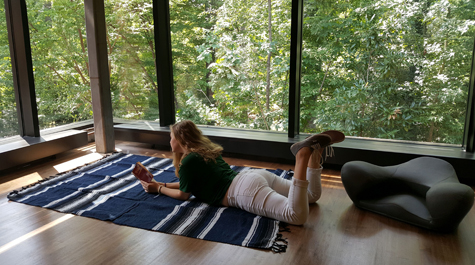 Crace said that students who have explored the building so far have shown a great deal of curiosity in its offerings and have already begun using the multipurpose rooms and meditation alcoves as well as the clinical services.
Crace said that students who have explored the building so far have shown a great deal of curiosity in its offerings and have already begun using the multipurpose rooms and meditation alcoves as well as the clinical services.
“They seem really comfortable and curious about what’s going on, and that’s just what we hoped for,” he said.
Throughout the building’s first year, Crace said that he and his colleagues are going to listen and learn from students and look to find a rhythm.
“For everyone in this building, students and staff, it’s new to us, so we need to work through this transition period and then we need to find a rhythm that will help us feel like this is not only a healthy place for our students, it’s a really healthy place to work,” he said.
 Skip to main content
Skip to main content

